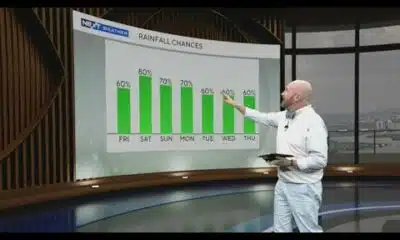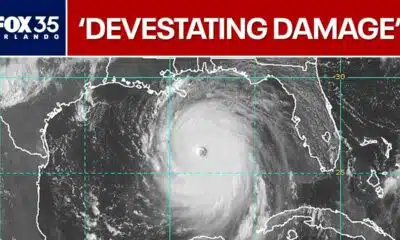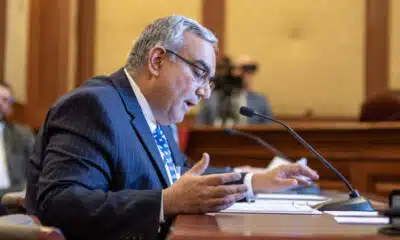News from the South - Louisiana News Feed
With no public debate, Louisiana enacts sales tax break on luxury boats
by Julie O’Donoghue, Louisiana Illuminator
July 10, 2025
While standing on the deck of a friend’s yacht last week in Bermuda, Gov. Jeff Landry praised a new Louisiana tax break on boat purchases in a short video he shared to social media.
“Louisiana’s been known as a sportsman’s paradise, but it’s not always treated our sportsmen friendly,” Landry said in the recording posted July 3.
“This year, we made Louisiana sportsman-friendly by capping the amount of taxes you pay when you buy you a new boat or register your boat in Louisiana,” the governor said as the wake of the multimillion-dollar vessel churned behind him.
What the governor didn’t mention is the tax break, which took effect July 1, only applies to boats worth $200,000 or more.
The yacht owner hosting Landry, Shane Guidry, is the governor’s close friend, political adviser and top campaign donor. Guidry told the Illuminator he personally suggested the tax break for luxury boats to the governor.
“I recommended to him a year ago that he should look at them,” he said in a phone interview from the 82-foot Viking yacht he took to Bermuda this month.
Guidry said he owns nine fishing and pleasure boats, including three yachts he estimated are worth a combined $50 million.
He is the head of Harvey Gulf International Marine, a billion-dollar marine transportation company that services the offshore energy sector. The business is based in New Orleans, but Guidry also spends several weeks a year on his passion project: Team Harvey Fishing, which competes in international tournaments for prize money.
A Metairie resident, Guidry registered his yachts in Palm Beach, Florida, where boat taxes were, until this month, far lower. Louisiana’s new tax break should entice high-end boat owners to register their watercraft locally, he said, resulting in more tax revenue for Louisiana.
“Something is better than getting zero,” he said.
The governor joined Guidry over the July 4 holiday while Team Harvey Fishing participated in the Bermuda Billfish Blast, the first of three consecutive tournaments in the British territory. This year, the event awarded $1.4 million in prize money.
The governor’s office declined to answer a question about whether the idea for the tax break came from Guidry.
Great news heading into the 4th of July weekend!
We’ve taken a big step toward making Louisiana even better for our sportsmen. This year, we capped the taxes you pay when buying or registering your boat here in Louisiana—making it more affordable to enjoy the Sportsman’s… pic.twitter.com/AKu5dJRTHG
— Jeff Landry (@JeffLandry) July 3, 2025
State officials say tax break will generate more money
In June, the Louisiana Legislature approved a cap of $20,000 on local and state sales taxes applied to boats as long as the taxes are paid within 90 days of a boat’s purchase. The provision was part of a larger omnibus bill sponsored by Rep. Julie Emerson, R-Carencro, that included several other, unrelated tax changes.
The cap will only benefit more expensive boats because the average combined local and state sales tax in Louisiana is 10% – or the equivalent of $20,000 on a $200,000 purchase. This limit will increase in the future; the law requires the $20,000 threshold to be adjusted for inflation every five years starting in 2030.
The break applies to purchases of personal boats and those tourist and fishing charter companies use. Commercial shrimpers and fishers won’t see any benefits because their boats are already exempt from sales tax.
State Revenue Secretary Richard Nelson said the change is meant to encourage Louisiana residents with pricier boats to bring them back home, as Guidry suggested. Many luxury boat owners register in other states to avoid Louisiana’s high taxes, Nelson said.
Florida and Texas, for example, have caps on taxes for most boats of $18,000 and $18,750 respectively, though Texas also applies a separate tax on certain types of boat motors.
“It’s a negligible cost if it costs us anything,” said Nelson, a Landry appointee, of the luxury boat tax break. “[The state] might end up making money.”
Emerson said the adjustment is also part of a wider policy discussion regarding the burden of sales taxes on big-ticket items such as recreational vehicles, high-end cars and boats.
Wealthy people have the ability to dodge Louisiana’s high tax rate on these items if they keep them in other states. Offering more local tax breaks might mean the government can collect at least some revenue on the purchases, she said.
“In my opinion, it is not going to make the state lose money. It’s going to make the state gain money,” Emerson said of the boat tax break.
Charter fishing tour operator Adam Peterson said he believes the tax break will be a boon for his industry. Many people who offer charter experiences lease their vessels from independent owners, but the tax break should result in fewer expenses for the charter companies, he said.
“Whenever we have to re-register [boats], we are going to register it in Louisiana,” said Peterson who owns Gulf of America Outfitters, which runs fishing charters out of Venice, Port Fourchon and Lake Charles.
The tax change comes at a time when most Louisiana residents are paying more in sales taxes however.
Seven months ago, Landry and lawmakers hiked the state sales tax rate across the board from 4.45% to 5% and expanded it to routine purchases, including streaming entertainment services and cable television subscriptions.
The tax increase is meant to partially make up for income and corporate tax cuts enacted at the same time, but it also left Louisiana with the highest average sales tax rate in the country.
“I don’t necessarily blame the boat owners for seeking an exemption, but the better long-term solution is to have a lower sales tax with a broader base,” said Steven Procopio, president of the Public Affairs Research Council of Louisiana, which studies state fiscal policies.
Lawmakers approved tax break quietly
Lawmakers passed the boat tax cap without public debate on the policy change.
The provision was quietly added to the larger sales tax bill June 12 in the final hours of the two-month legislative session. It was inserted through a conference committee, the secretive process in which six lawmakers negotiate and make changes to legislation in private before asking the full legislature to take a vote on a proposal.
Sen. Franklin Foil, R-Baton Rouge, said he wasn’t aware of the boat tax change, even though he was a member of the conference committee and pushed for the bill’s final approval in the Senate. He assumes it was one of several amendments requested by revenue department officials who work for the Landry administration.
“I don’t remember discussing the tax cap on boats during our conference meetings,” Foil said.
The final version of the bill passed overwhelmingly, with a 32-3 vote in the Senate and an 85-11 vote in the House.
“I think it’s a perfect example of our upside-down tax policy,” said Rep. Mandie Landry, D-New Orleans, a legislator who voted against the bill and is a member of the House committee that oversees tax policy.
“We are giving tax breaks to people who own very expensive boats but we can’t give tax breaks to people who own cheap cars or who have expensive insurance policy premiums,” she said.
Guidry’s boats likely to stay in Florida – for now
Assuming Guidry’s three yachts cost $50 million, he would have had to pay approximately $5 million in taxes to register them in Louisiana under the old law. Now, he would pay just $60,000.
But Guidry said he doesn’t plan to move any of the three boats from Florida soon. The transoms of the vessels have already been painted with his fishing team’s name and their home port – Palm Beach. It’s an expensive process he doesn’t want to redo, he said.
The offshore mogul said he might replace his largest yacht, a 130-foot Westport where Landry stayed during the Super Bowl in New Orleans earlier this year. If he upgrades to a 150-foot boat, Guidry said he will consider registering it in Louisiana.
Guidry appears to spare no expense when it comes to his yachts and isn’t shy about showing them off on social media.
The Team Harvey Fishing Instagram account includes several glamour reels of the 82-foot Viking yacht, which was completed for his team in early June.
One post from June highlights tissue boxes and blankets from luxury fashion brands Hermes and Louis Vuitton decorating the boat’s cabin. Another pans to an ottoman, custom-made for the yacht with Himalayan crocodile skin, according to the post caption. The material is famous because it is used in Hermes’ opulent Birkin bags, which sell for over $50,000.
Team Harvey Fishing posts are tagged with hashtags like #luxuryyacht #luxurylifestyle #yachtieworld #luxuryliving and #yachtinglife.
Accountability matters
If reporting like this is important to you, please consider a donation.
Louisiana Illuminator is part of States Newsroom, a nonprofit news network supported by grants and a coalition of donors as a 501c(3) public charity. Louisiana Illuminator maintains editorial independence. Contact Editor Greg LaRose for questions: info@lailluminator.com.
The post With no public debate, Louisiana enacts sales tax break on luxury boats appeared first on lailluminator.com
Note: The following A.I. based commentary is not part of the original article, reproduced above, but is offered in the hopes that it will promote greater media literacy and critical thinking, by making any potential bias more visible to the reader –Staff Editor.
Political Bias Rating: Center-Right
This article presents a largely factual report focused on a tax break enacted under Republican Governor Jeff Landry’s administration in Louisiana. The tone is generally neutral but includes subtle critical framing by highlighting the luxury nature of the beneficiaries, the connection between the governor and a wealthy donor, and the relatively quiet legislative process. The emphasis on how the tax break benefits wealthy boat owners, contrasted with rising general sales taxes, suggests a skeptical viewpoint typical of center-right or moderate conservative critiques emphasizing fiscal priorities and transparency. However, it does not adopt a strongly partisan or ideologically charged tone, maintaining an overall balanced approach with some mild critical undertones.
News from the South - Louisiana News Feed
Over $600k awarded for security upgrades at Jefferson Parish schools
SUMMARY: Jefferson Parish Schools received 13 grants totaling $605,600 from the Louisiana Center for Safe Schools program to enhance school security. Each school can receive up to $50,000 to improve facilities and create secure entry vestibules, which will control access and screen visitors before entering campuses. Superintendent Dr. James Gray emphasized the grants’ importance in ensuring safe learning environments, while COO Patrick Jenkins highlighted the peace of mind these upgrades provide. Chief District Affairs Officer Dr. LaDinah Carter noted the commitment to student and staff well-being. Specific schools received varying amounts, with most allocated $50,000 for these security enhancements.
The post Over $600k awarded for security upgrades at Jefferson Parish schools appeared first on wgno.com
News from the South - Louisiana News Feed
K+20: Katrina alters local health care landscape, though underlying ills still the same
by Wesley Muller, Louisiana Illuminator
August 28, 2025
When Dr. Granville Morse began his shift at Charity Hospital’s emergency room on Aug. 27, 2005, neither he nor his colleagues knew they would admit what would be the last patients in the institution’s 269-year history. Even as Hurricane Katrina undermined New Orleans’ faulty levees and crippled its power infrastructure two days later, he and others on staff tended to a surge in people needing health care.
They included nursing home residents evacuated to the hospital amidst rising floodwaters, only to be moved out once again after Charity’s basement became submerged and its generators were rendered useless. Morse helped bring patients across the flooded street to the helipad at Tulane Medical Center, which was conducting its own evacuation.
“People were trying to do the best they could,” he said. “We figured out a way to care for them.”
Before Katrina, Charity and other local hospital emergency rooms were often the primary care provider for a substantial portion of New Orleans-area residents, more than 20% of whom had no health insurance in 2005 according to the Congressional Research Service.
Out of 16 area hospitals, 13 had to close after the storm. Most have since reopened, some as specialty care centers, but Charity Hospital and Lindy Boggs Medical Center in Mid-City remain vacant. Two new acute-care facilities, University Medical Center and New Orleans East Hospital, have been added.
The decision to abandon Charity created great angst among residents whose families had relied on the hospital for generations. Yet local medical industry leaders say the city and region are now delivering a better standard of care while also able to better withstand a major natural disaster.
When Hurricane Ida knocked out power for much of the New Orleans region in 2021, University Medical Center operated off the grid for 11 days without incident, said Dr. John Heaton, president and chief medical officer of LCMC Health, which operates the hospital.
“It’s gonna have to be a really big one for UMC to evacuate,” Heaton said. “UMC is built like a fortress. You can barely tell the wind’s blowing outside.”
LCMC Health and Ochsner Health System, two of the state’s leading health care providers, own or run many medical facilities in the region. Both have also opened or acquired dozens of urgent care clinics, in part to meet post-Katrina care needs and in line with a national move away from hospital-based care.
“The shuttering of some of the hospitals after Katrina allowed us to back up and think about how to develop health care in actual neighborhoods … where patients are within walking or biking distance,” said Dr. Michael Griffin, CEO of DePaul Community Health Centers. The organization has expanded from one New Orleans-area clinic to 11 since 2005.
Compared with other southeastern states, Louisiana has markedly better access to care, according to data from the United Health Foundation, which conducts one of the nation’s longest running state-by-state health assessments. However, the Pelican State has been unable to improve its overall health ranking from the worst in the nation. The foundation ranked Louisiana 50th both in 2004 and in its most recent report from 2024.
Affordable Care Act fills care gaps
In the immediate wake of Katrina’s devastation, a handful of local medical students and residents set up six makeshift medical aid stations around the city. Their goal was to care for the uninsured and marginalized populations that had previously relied on Charity Hospital.
This was the genesis for the community-centered model of health care for New Orleans, Morse said.
Morse credits Tulane physician Dr. Karen DeSalvo for spearheading the community health model now present in Louisiana. She would go on to lead the city health department from 2011-14 and join the Obama administration as the assistant U.S. health secretary. DeSalvo is now chief medical officer for Google.
“There was no doubt in my mind that we could not return to a system where we trained our students in hospital based clinics and miss the opportunity to embed them in the community.” DeSalvo told a congressional committee in 2009.
For generations, low-income, uninsured and largely minority citizens relied on Charity Hospital for their medical care. But the hospital was overwhelmed and underfunded, DeSalvo told lawmakers. If patients missed an appointment for any reason, it could be a 12-month wait until the next available appointment, so most patients accessed the system through the emergency room, she said.
The same was true at some of the city’s other hospitals, according to Griffin.
“Those were very vital and critical access points for the community,” he said.
Often when uninsured patients were treated at emergency rooms, they couldn’t afford follow-up care from Charity and other hospitals. At the time, Medicaid didn’t cover the entire cost for health care providers.
“Many hospitals avoided taking Medicaid patients because they couldn’t afford to,” Heaton said. “A lot of advanced therapies just weren’t available (to patients).”
While urgent care and outpatient facilities changed the local health care landscape in the decade after Hurricane Katrina, medical professionals credit a major policy change with improving outcomes for their low-income patients.
In 2016, Democratic Gov. John Bel Edwards chose to expand Medicaid services through funding provided under the Affordable Care Act. His Republican predecessor, Bobby Jindal, had shunned expansion while in office.
More than 433,000 Louisiana residents enrolled for the coverage within the first year it was available, state figures show. As of 2022, the number had increased to 638,000, largely the result of relaxed Medicaid rules during the COVID-19 pandemic.
As of 2023, more than 133,000 New Orleans residents, or 36.5% of the city’s population, were covered under Medicaid. Updated official data isn’t available, but the count has likely dropped in the past two years through state efforts to cull the rolls once the pandemic standards expired.
Studies have shown the Affordable Care Act helped fill health care gaps Katrina left in Louisiana through significant funding for federally qualified health centers, which provide care regardless of a patient’s ability to pay. The Louisiana Department of Health estimated 45 such centers existed in the state before Katrina. Over the past 20 years, that number has grown to more than 260, according to federal data.
The new federally qualified health centers include DePaul’s clinics, some of which offer services that were once only found at large hospitals. Its nonprofit clinics typically provide primary care, mental health, dental, podiatry, optometry and pharmacy services — all in one building or complex and often within walking or biking distance to the people who need it most, Griffin said.
“You’re always going to need hospitals,” Griffin said. “But access has definitely improved.”
GET THE MORNING HEADLINES.
Poverty rates unchanged over 20 years
Dr. Gerry Cvitanovich opened his first urgent care clinic in Kenner in 2002 and was building a second one in Metairie right before Katrina hit. He reopened his Kenner clinic without electricity about 10 days after the storm and began seeing swarms of new patients with different kinds of ailments. Many needed medication refills because they ran out during the storm.
“We were overrun,” Cvitanovich said. “We were overrun with people who needed basic things.”
He recalls seeing patients who had relied on Charity Hospital for their care but had none of their medical records available. The move to digital medical records since the storm has been a great benefit, particularly when patients are displaced by disasters, he said.
Cvitanovich went on to open 14 urgent care clinics in the New Orleans region, eventually selling them to Ochsner Health System in 2017. He’s now part of the system’s medical staff and has served as Jefferson Parish coroner since 2012.
The doctor agreed that health care has become more accessible since Katrina but said access is only one part of the equation to making people healthier.
More change ahead for New Orleans public schools 20 years after Katrina
Studies have shown significant links between poverty and health. People with limited finances often have more difficulty obtaining health insurance or paying for expensive procedures and medications. Factors such as limited access to healthy foods and higher instances of violence can increase stress and the accompanying health risks.
Residents of impoverished communities are at increased risk for chronic disease, higher mortality, lower life expectancy and mental disorders, according to the U.S. Department of Health and Human Services. The agency also points to natural disasters and pollution as drivers of poverty and poor health in Louisiana.
Before Katrina, approximately 23% of New Orleans residents were living below the federal poverty line — $19,350 for a family of four, according to federal data. Over 20 years, the city’s poverty rate has shown next to no progress, now sitting at 22.6%, according to the Federal Reserve.
Louisiana as a whole has seen a similar trend. The state poverty rate was 19.4% in 2004 and is now at 18.9%, with the poverty line set at $32,150 for a four-person household.
Children make up the largest age group of those experiencing poverty, and this too is more prominent in Louisiana than any other state, according to data from the Kaiser Family Foundation. Childhood poverty is associated with developmental delays, toxic stress, chronic illness and nutritional deficits, according to the health department.
In response to these trends, Griffin said the community health care model has been adapted to include school-based clinics. DePaul now provides services, with parental consent, at 23 New Orleans-area schools. The basic idea is to treat patients where they are and closer to home because some people cannot take off work to see a doctor or have no means of reliable transportation, he said.
When possible, LCMC Health goes beyond its medical care role to address public health issues, Heaton said. For example, it has distributed gun safes to parents at Children’s Hospital.
“It’s really not our purview,” Heaton said, adding that public agencies need to address underlying socioeconomic factors behind poor health outcomes in the state.
Morse agreed that the government and other organizations have a larger role to play when it comes to health care.
“There’s only so much we can do,” Morse said. “Health systems are more prepared but only as good as the systems around it.”
YOU MAKE OUR WORK POSSIBLE.
Louisiana Illuminator is part of States Newsroom, a nonprofit news network supported by grants and a coalition of donors as a 501c(3) public charity. Louisiana Illuminator maintains editorial independence. Contact Editor Greg LaRose for questions: info@lailluminator.com.
The post K+20: Katrina alters local health care landscape, though underlying ills still the same appeared first on lailluminator.com
Note: The following A.I. based commentary is not part of the original article, reproduced above, but is offered in the hopes that it will promote greater media literacy and critical thinking, by making any potential bias more visible to the reader –Staff Editor.
Political Bias Rating: Center-Left
This content leans center-left, primarily due to its favorable depiction of public health initiatives, Medicaid expansion, and community-based health care reforms following Hurricane Katrina. It highlights the positive impacts of Democratic policy decisions, such as Medicaid expansion under Democratic Governor John Bel Edwards and the Affordable Care Act, while acknowledging systemic issues like poverty and healthcare access. The article focuses on social determinants of health and the role of government programs without heavy criticism of either political side, which grounds it in a thoughtful, progressive perspective oriented toward public welfare and social equity.
News from the South - Louisiana News Feed
2 children killed, 17 people wounded in shooting at Minneapolis Catholic school
SUMMARY: A gunman opened fire through windows at Annunciation Catholic Church in Minneapolis during a Wednesday morning Mass, killing two children, ages 8 and 10, and injuring 17 others, including 14 children and three elderly adults. The shooter, 23-year-old Robin Westman, armed with a rifle, shotgun, and pistol, died from an apparent self-inflicted gunshot wound. Police described the attack as deliberate and incomprehensibly cruel, targeting innocent worshippers. Authorities are investigating a manifesto Westman posted online. The FBI is treating the incident as domestic terrorism and a hate crime against Catholics. Community members and leaders expressed profound grief and solidarity.
The post 2 children killed, 17 people wounded in shooting at Minneapolis Catholic school appeared first on wgno.com
-
News from the South - Texas News Feed4 days ago
Racism Wrapped in Rural Warmth
-
News from the South - Texas News Feed6 days ago
DEA agents uncover 'torture chamber,' buried drugs and bones at Kentucky home
-
News from the South - Texas News Feed7 days ago
Abrego Garcia released from prison, headed to family
-
Our Mississippi Home6 days ago
Spit Me Out Quick – How Lubber Grasshoppers Survive
-
News from the South - Florida News Feed7 days ago
Chinese bridge collapse kills at least 12 construction workers
-
News from the South - Missouri News Feed5 days ago
Donors to private school voucher program removed from Missouri transparency site
-
SuperTalk FM7 days ago
Mississippi stores affected by Blue Bell ice cream recall over packaging mishap
-
News from the South - Alabama News Feed4 days ago
Child in north Alabama has measles, says Alabama Department of Public Health











































